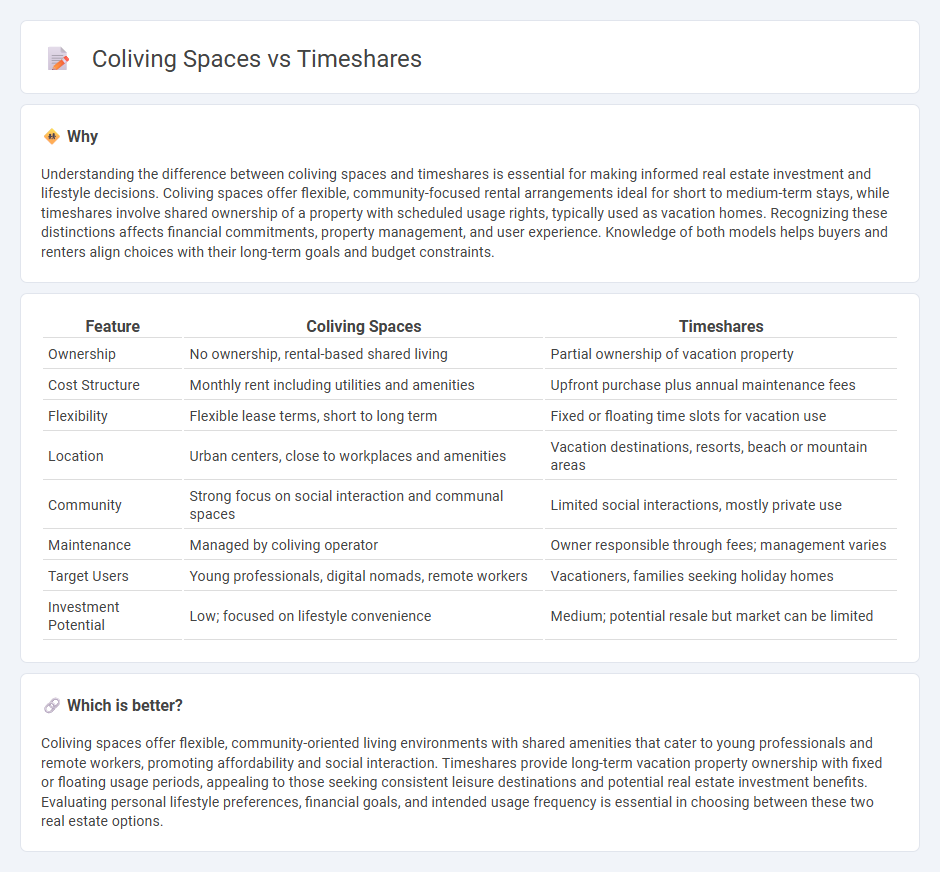
Coliving spaces offer flexible, community-driven housing solutions with shared amenities and shorter lease terms, contrasting with timeshares, which involve purchasing ownership rights for vacation properties with fixed or rotating usage periods. Coliving prioritizes affordable urban living and social interaction, while timeshares focus on long-term vacation property investment and exclusive access. Explore the differences in cost, flexibility, and lifestyle to find the ideal real estate option for your needs.
Why it is important
Understanding the difference between coliving spaces and timeshares is essential for making informed real estate investment and lifestyle decisions. Coliving spaces offer flexible, community-focused rental arrangements ideal for short to medium-term stays, while timeshares involve shared ownership of a property with scheduled usage rights, typically used as vacation homes. Recognizing these distinctions affects financial commitments, property management, and user experience. Knowledge of both models helps buyers and renters align choices with their long-term goals and budget constraints.
Comparison Table
| Feature | Coliving Spaces | Timeshares |
|---|---|---|
| Ownership | No ownership, rental-based shared living | Partial ownership of vacation property |
| Cost Structure | Monthly rent including utilities and amenities | Upfront purchase plus annual maintenance fees |
| Flexibility | Flexible lease terms, short to long term | Fixed or floating time slots for vacation use |
| Location | Urban centers, close to workplaces and amenities | Vacation destinations, resorts, beach or mountain areas |
| Community | Strong focus on social interaction and communal spaces | Limited social interactions, mostly private use |
| Maintenance | Managed by coliving operator | Owner responsible through fees; management varies |
| Target Users | Young professionals, digital nomads, remote workers | Vacationers, families seeking holiday homes |
| Investment Potential | Low; focused on lifestyle convenience | Medium; potential resale but market can be limited |
Which is better?
Coliving spaces offer flexible, community-oriented living environments with shared amenities that cater to young professionals and remote workers, promoting affordability and social interaction. Timeshares provide long-term vacation property ownership with fixed or floating usage periods, appealing to those seeking consistent leisure destinations and potential real estate investment benefits. Evaluating personal lifestyle preferences, financial goals, and intended usage frequency is essential in choosing between these two real estate options.
Connection
Coliving spaces and timeshares both offer flexible, community-focused housing solutions that optimize property usage and affordability. Timeshares provide shared ownership with scheduled access to vacation homes, while coliving spaces emphasize communal living with shared amenities in urban settings. Both models respond to shifting consumer preferences towards cost-effective, social, and convenience-driven real estate options.
Key Terms
Ownership Structure
Timeshares involve fractional ownership of a vacation property, allowing buyers to use the property for a specific time period each year, while coliving spaces offer flexible, lease-based accommodation with shared amenities and communal living without ownership stakes. Timeshare owners have equity and the option to resell their share, whereas coliving residents typically pay rent without long-term investment or property rights. Explore more to understand which ownership structure aligns best with your lifestyle and financial goals.
Usage Rights
Timeshares grant buyers the right to use a property for a fixed period each year, typically offering long-term ownership without full property rights, while coliving spaces provide flexible, subscription-based access to shared accommodations with no ownership stakes. Usage rights in timeshares are legally defined and often come with restrictions on resale and duration, whereas coliving agreements prioritize convenience and communal living with month-to-month leases or memberships. Explore the detailed differences in usage rights to determine which option aligns best with your lifestyle and investment goals.
Community Amenities
Timeshares typically offer private ownership of vacation properties with amenities such as pools, fitness centers, and recreational areas designed for occasional use. Coliving spaces emphasize shared community amenities like communal kitchens, coworking areas, and social lounges to foster interaction and collaboration among residents. Explore more to understand which option aligns best with your lifestyle and community preferences.
Source and External Links
RedWeek - Offers a platform to rent or buy timeshare properties from owners worldwide, providing over 5,000 resorts to choose from.
Consumer Advice by FTC - Provides crucial information and warnings about timeshares, including potential scams and hidden charges.
Wikipedia: Timeshare - Explains the concept of timeshares, their history, and various types, such as deeded and points-based systems.
 dowidth.com
dowidth.com